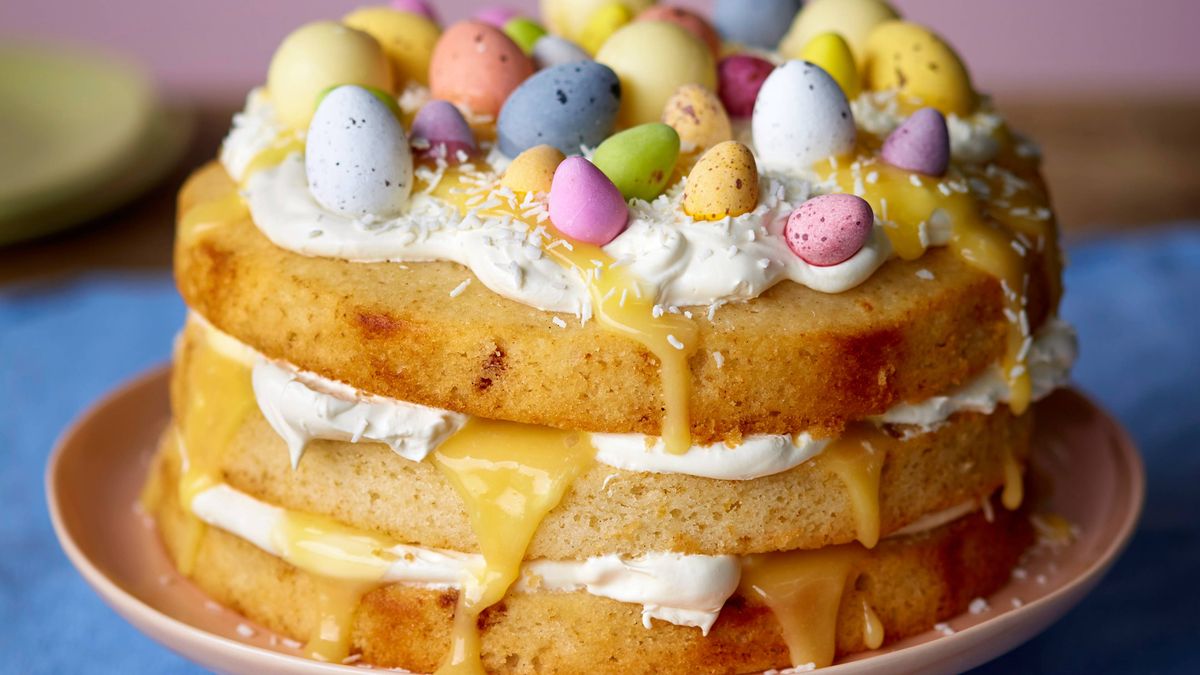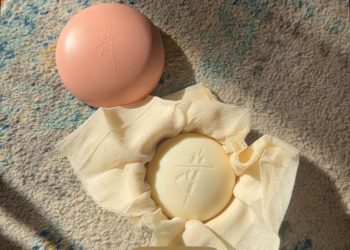Our Easter coconut and lemon cake is filled with whipped cream and zingy lemon curd. The kids will love decorating the top with chocolate treats and desiccated coconut.
We love the appearance of a triple-layered cake but if you’ve only got two tins just bake two slightly thicker sponges. You will likely need to add a few minutes to the baking time. The sponge can be made the day before and then you could assemble and decorate the cake with your kids just before you want to serve it.
Ingredients
For the sponges:
- 4 medium eggs
- 375g (13oz) caster sugar
- 45g (11⁄2oz) creamed coconut block, finely grated
- 200ml (7fl oz) sunflower oil
- 284ml carton buttermilk
- 1tbsp vanilla extract
- 300g (10oz) plain flour
- 45g (11⁄2oz) desiccated coconut
- 1tsp baking powder
- 1⁄2tsp bicarbonate of soda
For the lemon curd:
- 100g (31⁄2oz) caster sugar
- 60g (2oz) butter
- Juice of 2 lemons, plus the zest of 1
- 2 eggs, beaten
To finish:
- 300ml (10fl oz) cream, softly whipped
- 1tbsp desiccated coconut, to sprinkle
- Chocolate eggs and truffles, to decorate – we used Cadbury Mini Eggs, Doisy & Dam Vegan Good Eggs, Divine Milk Chocolate Speckled Eggs, and Lindt Lindor White Chocolate Truffles
You will need:
- 3 x 20cm (8in) springform cake tins, greased and lined with parchment paper
Method
- Heat the oven to 180C (160C fan, Gas 4). For the sponges, beat the eggs, sugar and creamed coconut for a few mins until slightly thickened.
- Pour in the oil, buttermilk and vanilla extract, and mix until blended well.
- Add the flour, desiccated coconut, baking powder and bicarbonate of soda, and mix until just combined.
- Divide the mixture equally between the 3 cake tins. Place in the oven on the middle shelf to cook for 20-25 mins, until just turning a pale golden brown and the sponge is springy to the touch.
- Remove them from the oven, then turn them out of the tins onto a wire rack to cool completely before finishing the cake.
- While the sponges are cooking, prepare the lemon curd. In a small pan over a medium heat, heat the sugar and butter with the lemon juice and zest until the butter has melted. Whisk in the eggs and turn the heat to medium-low, whisking continuously until the curd begins to thicken. When it’s thick enough to coat the back of a wooden spoon, remove from the heat and pour into a bowl to cool. Cover with cling film and set aside.
- To assemble the cake, make sure the sponges and lemon curd are cool. Lay 1 round of sponge on the base of a cake stand and spread over a third of the whipped cream and a third of the curd. Continue layering sponge, cream and curd. Sprinkle with desiccated coconut and top with the decorations of your choice.
Top tips for making our Easter coconut and lemon cake
You can assemble the cake ahead of time but we’d recommend adding the chocolates to the top just before serving. When the cake is in the fridge the colours might weep into the cream otherwise. We like to remove it from the fridge around 10 minutes before you want to slice and serve as it’s more enjoyable than if the cake is ‘fridge’ cold.
What can I use instead of lemon curd?
For a quicker recipe that still has a zingy flavour, use some raspberry jam instead. You can also use a jar or curd if you don’t have time to make your own.
What can I use if I don’t have buttermilk?
Swap for the same weight of natural yogurt instead. Don’t be tempted to use a low-fat or fat-free yogurt because it will affect the flavour and final bake. Yogurt will give you the same subtle tangy flavour and a lovely moist sponge.
Food Writer
“If you’d like a slightly lighter filling and topping, consider using half cream and half yogurt. Preferably a thick set one. Softly whip the cream first and then fold in the yogurt.”
To make sure the cakes are even, we’d recommend weighing the batter and dividing it equally between the three cake tins.
For more Easter inspiration, try our easy Easter nests. We have lots more Easter foods you can enjoy making with the kids and a simple guide on how to make your own Easter eggs.




















